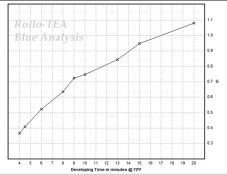sanking
Member
During the last several months I have experimented with a number of variations on existing pyro formulas using both propylene glycol and TEA , or triethanolamine, inspired in part by the recent experiments of Pat Gainer with these agents.
Most recently I did quite a number of tests with a new formula that I call Rollo-TEA. Rollo-TEA, though inspired by the Rollo Pyro formula introduced some years ago by Harald Leban, is an entirely new developer, different from the model in both composition and results.
For 100 ml of stock solution, mix in the order as noted below. For a liter of stock solution multiply the amounts by 10X.
Rollo-TEA
TEA at 175º F
Potassium bromide 0.2 g
Sodium bisulfite 2.0 g
Pyrogallol 15.0 g
Ascorbic acid 1.0 g
Phenidone 0.2 g
Add TEA to 100 ml
For use, dilute 1:100 for silver printing or 2:100 for alternative work. Persons who have previously used Rollo Pyro should note that the substitution of phenidone in place of metol at a ratio of one part phenidone for ten parts metol gives a lot of additional synergism to the developer and shortens development times considerably.
The advantage of the Rollo-TEA formula, in comparison to the original Rollo Pyro formula, are as follows.
1. Rollo-TEA is a single solution developer to which one need add only water to have a working solution.
2. With the substitution of phenidone for metol at the ratio of one part phenidone to ten parts metol there is a significant increase in synergism. This gives shorter development times.
3. Very clean working, with very low B+F values.
The color of the stain is typical of pyrogallol based developers, ranging from greenish to greenish/yellow, or yellow/brown. For this reason Rollo-TEA will give results with VC papers similar to PMK and the original Roll-Pyro formula, in contrast to what one might see with the brown stain of developers such as Diaxactol and Pyrocat-HD.
Sandy
Most recently I did quite a number of tests with a new formula that I call Rollo-TEA. Rollo-TEA, though inspired by the Rollo Pyro formula introduced some years ago by Harald Leban, is an entirely new developer, different from the model in both composition and results.
For 100 ml of stock solution, mix in the order as noted below. For a liter of stock solution multiply the amounts by 10X.
Rollo-TEA
TEA at 175º F
Potassium bromide 0.2 g
Sodium bisulfite 2.0 g
Pyrogallol 15.0 g
Ascorbic acid 1.0 g
Phenidone 0.2 g
Add TEA to 100 ml
For use, dilute 1:100 for silver printing or 2:100 for alternative work. Persons who have previously used Rollo Pyro should note that the substitution of phenidone in place of metol at a ratio of one part phenidone for ten parts metol gives a lot of additional synergism to the developer and shortens development times considerably.
The advantage of the Rollo-TEA formula, in comparison to the original Rollo Pyro formula, are as follows.
1. Rollo-TEA is a single solution developer to which one need add only water to have a working solution.
2. With the substitution of phenidone for metol at the ratio of one part phenidone to ten parts metol there is a significant increase in synergism. This gives shorter development times.
3. Very clean working, with very low B+F values.
The color of the stain is typical of pyrogallol based developers, ranging from greenish to greenish/yellow, or yellow/brown. For this reason Rollo-TEA will give results with VC papers similar to PMK and the original Roll-Pyro formula, in contrast to what one might see with the brown stain of developers such as Diaxactol and Pyrocat-HD.
Sandy
Last edited by a moderator:













